
DonQui takes time out from his busy schedule of lazing about under the Caribbean sun to tap out a few words for his blog

DonQui takes time out from his busy schedule of lazing about under the Caribbean sun to tap out a few words for his blog

Avid readers of DonQui Oaty’s blog will be aware by now that he has a great fondness for chocolate.

It is hardly surprising, therefore, that when Duchess asks him where he would like to go for dinner, DonQui suggests the Boucan restaurant on Hotel Chocolat’s cocoa plantation.

According to the blurb the Hotel Chocolat’s restaurant: “explores the sweet and savoury nature of cocoa, together with the superb local produce found on Saint Lucia.” It is all about chocolate and every dish has at least some in it — even if only a few roasted cacao nibs.
DonQui’s starter is chicken liver parfait with poached pear, chocolate and black pepper-cacao nib crumble. The chocolate adds a rich spiciness to the liver and the pear balances the flavours nicely. The dish has quite an exotic taste — too rich to sample very often but DonQui is very glad to have experienced it.

Duchess feels much the same about her cacao pasta filled with mahi-mahi fish and goat’s cheese — looks fabulous, most interesting taste but perhaps not something one would want to eat every day. This, of course, is the whole point of a special dining experience such as this.

Chocolate is less in evidence in the main courses. Chocolate spiced lentils with chickpeas and naan bread are a big hit with Duchess while DonQui tucks into a delicious local kingfish filet served with roast pineapple and dasheen. There is little evidence of chocolate here apart from a few nibs on top and a coconut sauce made with cocoa butter.
 All of this is nicely washed down by a fine Côtes de Provence rosé from a very good wine list put together by Berry Bros of London.
All of this is nicely washed down by a fine Côtes de Provence rosé from a very good wine list put together by Berry Bros of London.

As one might expect there are lots of chocolate delectables for desert but there are other options including one of Duchess’ favourites — Rum Baba with a good shot of the local St Lucian rum.

The atmosphere is smart and laid-back at the same time. The restaurant is spacious, tastefully decorated in Hotel Chocolat’s trademark dark chocolate brown with magnificent views out over the estate. The staff are all very friendly and professional and diner was enhanced by a musician playing Bob Marley and Santana at just the right volume.

DonQui is very glad he came and thought it was a most memorable experience. He highly recommends trying Hotel Chocolat at least once — an absolute must for chocoholics and adventurous diners looking for new flavour combinations.
For those not planning on going to St Lucia just yet, Hotel Chocolat also has restaurants in the UK; in London and Leeds.

“Welcome to Paradise!” announces the jovial Mr Mugabe as DonQui trots out into the pleasant 28º heat at St Lucia’s Hewanorra airport. It turns out that the taxi driver’s name is McGuiver not Mugabe but DonQui’s ears have yet to become attuned to his West Indian accent.

A proud St Lucian, Mr McGuiver drives DonQui south along the shore, proclaiming that he has lived on the island all his life and has never been anywhere else. When one lives in paradise it seems a bit pointless contemplating travels to another place.

And first impressions do seem to confirm Mr McGuiver’s opinion.

DonQui’s destination is Sugar Beach, a wonderful secluded estate set between the two Piton mountains on a lush hillside that used to be a sugar plantation. At the bottom of the hill is a pristine beach of white sand looking out onto a protected bay on the Caribbean side of the southern tip of the island.

The accommodation is pretty decent too. DonQui’s villa is set on the hillside complete with plunge pool cascading over the edge of a verandah with views of the bay beyond.

Inside all is pristine white with every comfort and convenience a globe-trotting donkey might require, including an on-call butler at the other end of a handy local mobile phone. One downside is that the villa is a long stroll from the beach. This is not too bad going down but is a bit of a trek coming back up the hill. Fortunately there are frequent tuc tucs roaming around the estate to whisk people from place to place. The other downside is the price. This sort of luxury does not come cheap but for an occasional indulgence DonQui thinks it well worth the lightening of his purse.

Evidence of the French manager and French chef can be seen in the elegantly understated details and the quality of the food and drink. DonQui had not expected to be drinking a fine Alsatian Pinot Noir in the Caribbean but he enjoys one here.

The food excellent but it is not cheap, nor most especially is the wine. There is a price to be paid for a reliance on French imports and although DonQui is a great fan of French cuisine he thinks a nod or two to local dishes with local ingredients would not go amiss.
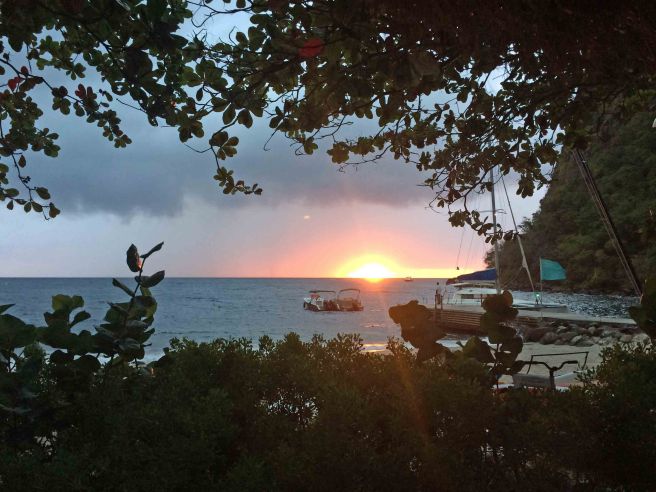
As the sun begins to set, DonQuis sips on a complimentary piton beer, listens to the sounds of a rather good jazz duo and looks out over the Anse des Pitons. It would be hard to imagine anywhere he would rather be at this moment.

The affable resort manager was recently quoted saying that he has tried to create a sanctuary where everyday life is left outside the gates. DonQui thinks he has succeeded.

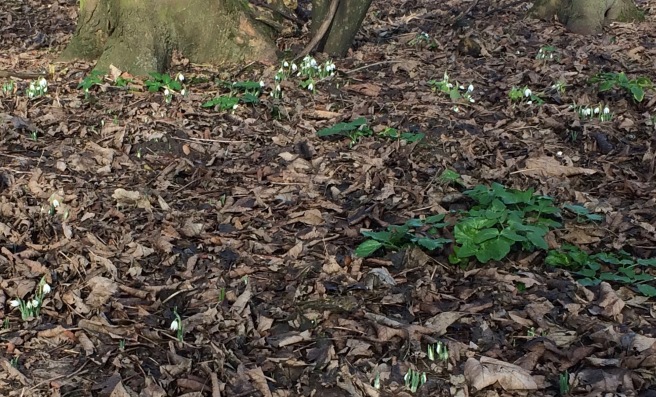 The first snow drops may be on their way…
The first snow drops may be on their way…
 … And Don Qui’s favourite Mosaic summer ale may be back on tap at his local.
… And Don Qui’s favourite Mosaic summer ale may be back on tap at his local.
Both of these are signs that Spring must be just around the corner. But it does not feel like it.
DonQui is heartily sick of the long cold, grey, damp, winter and so he has decided to head off to find some winter sun.

His flight leaves from Gatwick Airport in the morning. Not being a great early morning animal he decides to stay overnight at the Bloc Hotel which is right inside Gatwick’s Terminal 2 by the departure gates from where his British Airways flight will be departing in the morning.
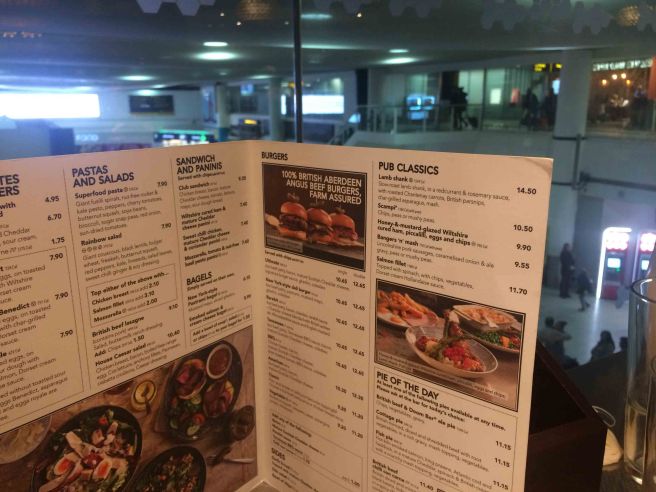
A Weatherspoons’ pub is not the sort of establishment Don Qui would normally frequent. There are not any better options so not expecting much Don Qui goes inside in search of some refreshment. While far from gourmet, it is surprisingly OK and reasonable value for money.
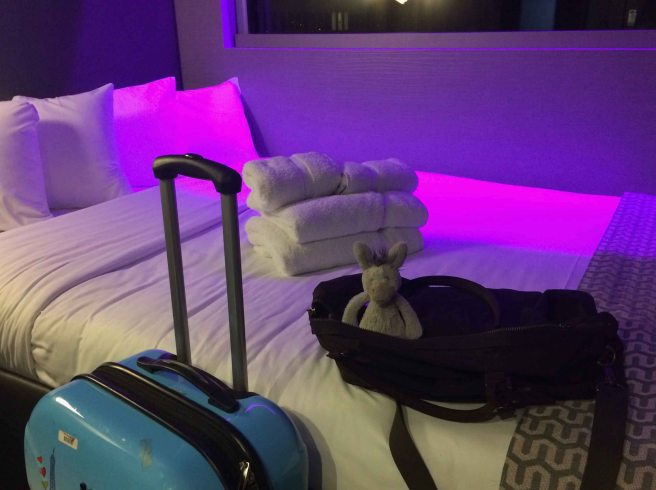
The Bloc Hotel is clean, functional, modern and has a few nice touches. Don Qui has stayed here before and finds the handy location by the departure gates more than make up for the somewhat utilitarian surroundings.

Continuing his enthusiasm for great veal dishes DonQui offers his take on the classic north Italian osso bucco. Originating from Milan, osso bucco translates roughly as ‘bone with a hole’ which is probably why it is never translated on menus.

Osso bucco is made from thick slices taken from across a calf shank with the bone in the centre filled with delicious marrow. This dish is all about the sauce and the marrow. It is frequently served in restaurants in a tomato based sauce and the first time DonQui tried osso bucco it was served this way. The classic version, however, is cooked in a white wine reduction without tomatoes and DonQui resolves to try such a version.
For once DonQui takes notice of the quantity he uses in his recipe, although his measurements are typically quite approximate. He is making this just for himself so the measurements are for one person. This should make the mathematics of scaling it up for several people relatively easy — even for someone as numerically challenged as DonQui.
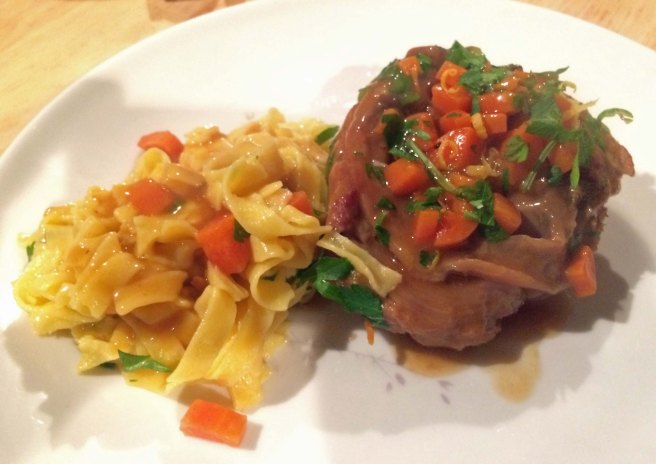
Ingredients
1 slice of veal shin. If you ask a good butcher for osso bucco he should know what you mean.
a tablespoon of flour seasoned with salt and ground white pepper for dusting the meat
1/2 an onion, finely chopped
1/2 a celery stick, finely chopped
2 small carrots, finely chopped
a handful of mushroom stalks, skins or bits finely chopped (optional)
a few chunks of pancetta or speck (optional)
2 tbsp olive oil and a knob of unsalted butter for frying
zest of one lemon
4 sage leaves
150ml dry white wine
150ml chicken stock
2 teaspoons of cornflour mixed with a little water for thickening the sauce (optional)
salt to taste.
Method

Pat dry the meat and dredge it with the seasoned flour
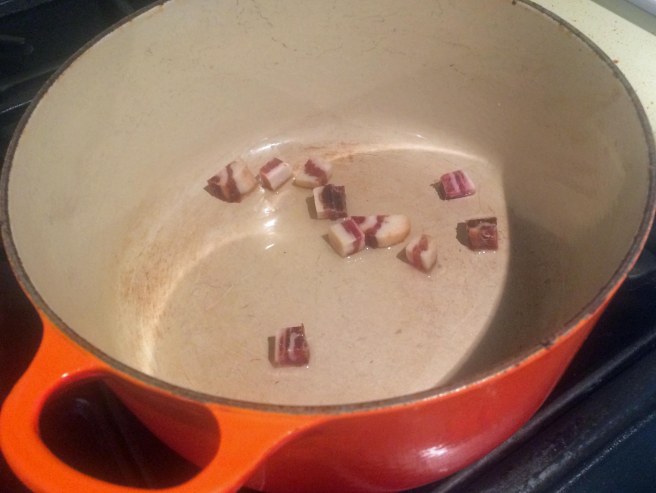
Brown the pancetta or speck in a little of the oil then take out and set aside. This will add a bit of a smokey taste to the sauce which is not absolutely necessary and not part of a classic recipe but DonQui likes it.

Add more oil and brown the meat on both sides over medium-high heat in a heavy bottomed pan or casserole. Then take it out and set to one side.

Add the butter along with the chopped onion, celery, mushrooms and one of the chopped carrots, reserving the second carrot for later. Cook together over a medium heat until the vegetables soften, reduce and begin to colour. Then add a sprinkle of salt, the sage and the lemon zest.
The mushroom bits are not essential but as DonQui has some leftovers in the fridge he decides to use them to give added depth to the sauce.

Turn up the heat, add the white wine and let it reduce by about half.
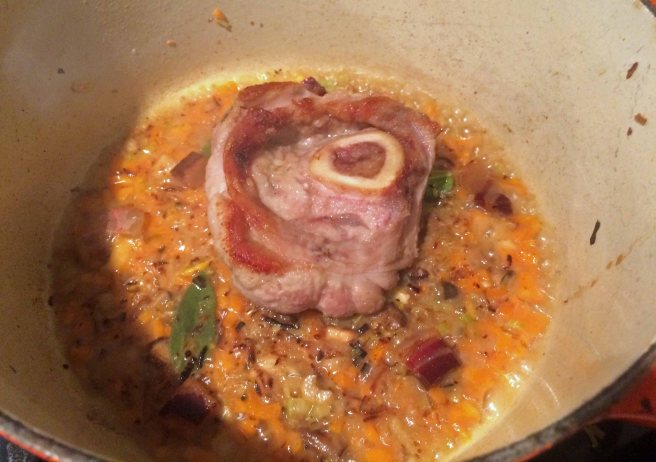
Place the meat on top of the vegetables, add the stock, bring it to the boil. Then cover and let it simmer very gently over a low heat for one and a half to two hours. Check progress and gently turn the meat every 30 minutes or so until the meat is very tender.
Up to this point you can do everything in advance, leaving it off the heat to finish the final steps later.
Ten to 15 minutes before serving, gently take the meat out of the sauce and place to one side. Then strain the sauce and discard the vegetables. This is not an essential step and a classic recipe will not call for it. DonQui, however, is not keen on vegetables which have been cooked for a couple of hours. They have done their job by imparting their flavour to the sauce.

Put the meat and the strained sauce back into the pan along with the second chopped carrot. Bring it all back up to the boil and simmer for 5-10 minutes until the new carrot bits are cooked but still retain a little crunch (this is how DonQui likes them!).
Taste for seasoning, adding a little more salt or pepper if you think the sauce needs it. You might also wish to considering it reduce a little more uncovered. Then, if you prefer a slightly thickened sauce, add the cornflour/water mixture and bring back up to just boiling so that it thickens.
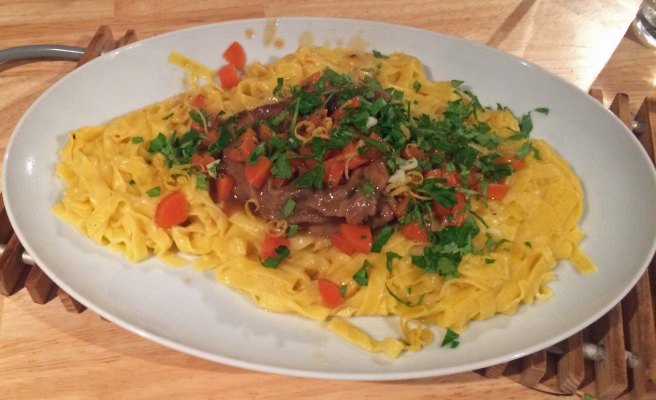
Traditionally Italians tend to eat a meat course on its own without any accompaniment but DonQui likes to serve it with pasta or, perhaps, a saffron risotto. He spoons the carrots with some of the sauce on top of the meat with a sprinkling of gremolata on top and the remaining sauce on the side.
 Gremolata is simply a mix of chopped parsley, finely chopped garlic and lemon zest with a bit of salt.
Gremolata is simply a mix of chopped parsley, finely chopped garlic and lemon zest with a bit of salt.
DonQui thinks this version of osso bucco vastly superior to one cooked in a tomato base. Done this way the delicious flavour of the slow cooked veal shin comes through. Adding tomatoes tends to overpower it in his opinion.

For reasons DonQui’s cannot quite comprehend, most Brits don’t eat veal. Many seem to have animal welfare issues associated with it. Despite campaigns by various celebratory chefs, British ‘Rose Veal’ has not really caught on even though the calves are raised normally — giving a pinkish tinge to the meat and hence the name.
Adding to the absurdity, Calves’ liver seems to sell well enough — probably because it is not marketed as ‘veal’. Many people who might be squeamish about eating baby cows seem happy enough to eat even younger lambs while avoiding older mutton.
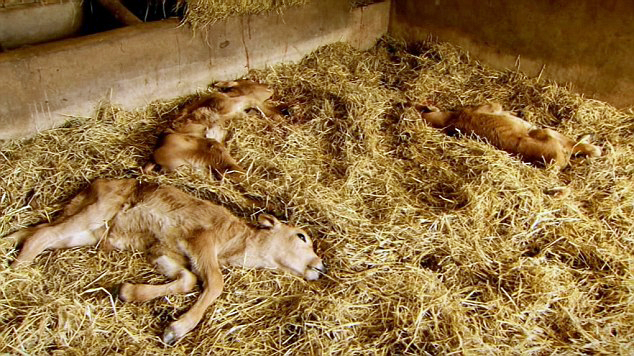
Coupled with an export ban, the result of misguided animal welfare concerns is that each year in the UK hundreds of thousands of male dairy calves are simply killed at birth and incinerated as there is no British market and they cannot be exported. DonQui thinks that this is a shameful waste. Veal is better for us than beef and it lends itself to a delicious range of cooking methods. It is actually one of his favourite meats.

The following recipe is one of his favourites, matching tender veal with mushrooms, wine and cream — a classic combination. He does not always approach it in quite the same way but if you follow this basic recipe you can play around with it as you wish.
Ingredients
Stewing veal cut into chunks. DonQui got his in France where it iwas labelled as ‘Sauté de Veau’. As this recipe involves slow cooking you do not need the very best nor the leanest cuts.
Mushrooms, halved or roughly sliced.
Dry or medium-dry white wine
Veal or chicken stock
Thick cream or crème fraîche
Chopped parsley
Salt and ground white pepper to taste.
Butter and oil for frying
A little corn flour mixed with water (optional in case you want a thicker sacue)
Method

Fry the mushrooms in butter and oil until they begin to colour and reduce. Take out of the pan with a slotted spoon and set aside.

Brown off the veal chunks in the same pan, adding a little more butter and oil if necessary.

Add a good glass of white wine (DonQui apologises for never measuring). Deglaze the pan, scraping up all the brown bits and then letting it reduce a little.
Add the stock (about the same amount as the wine), salt and pepper. Bring back up to the boil and then let it all simmer very gently, covered, for at least 1 1/2 hours or even longer. The idea is to cook it long and slow so that the meat starts to almost fall apart and all the flavour is imparted into the sauce. You could transfer it into a slow cooker if you wish. Be careful not to over-salt at this stage. A pinch will do. You can always add more later but much harder to take it out. Once the meat is beautifully tender you can leave it to finish off later.

Ten minutes before serving add the mushrooms you set aside earlier and let it all cook together for 5-10 minutes. Taste the sauce and maybe let it reduce a little to add greater depth of flavour. If you wish a thicker sauce then add the cornflour-water mixture and bring up to a gentle boil so that it thickens.

Then stir in a good dollop of cream and mix it in well on a low heat so it comes almost back up to the boil but not quite. If you cook it too vigorously at this stage the cream may separate.

Taste for seasoning then sprinkle with parsley and serve immediately.

DonQui likes this dish with noodles or rice. In this case he had it with egg tagliatelle with peas. The bright green peas add an appetising splash of colour. Carrots also go very well with the wine-cream sauce.